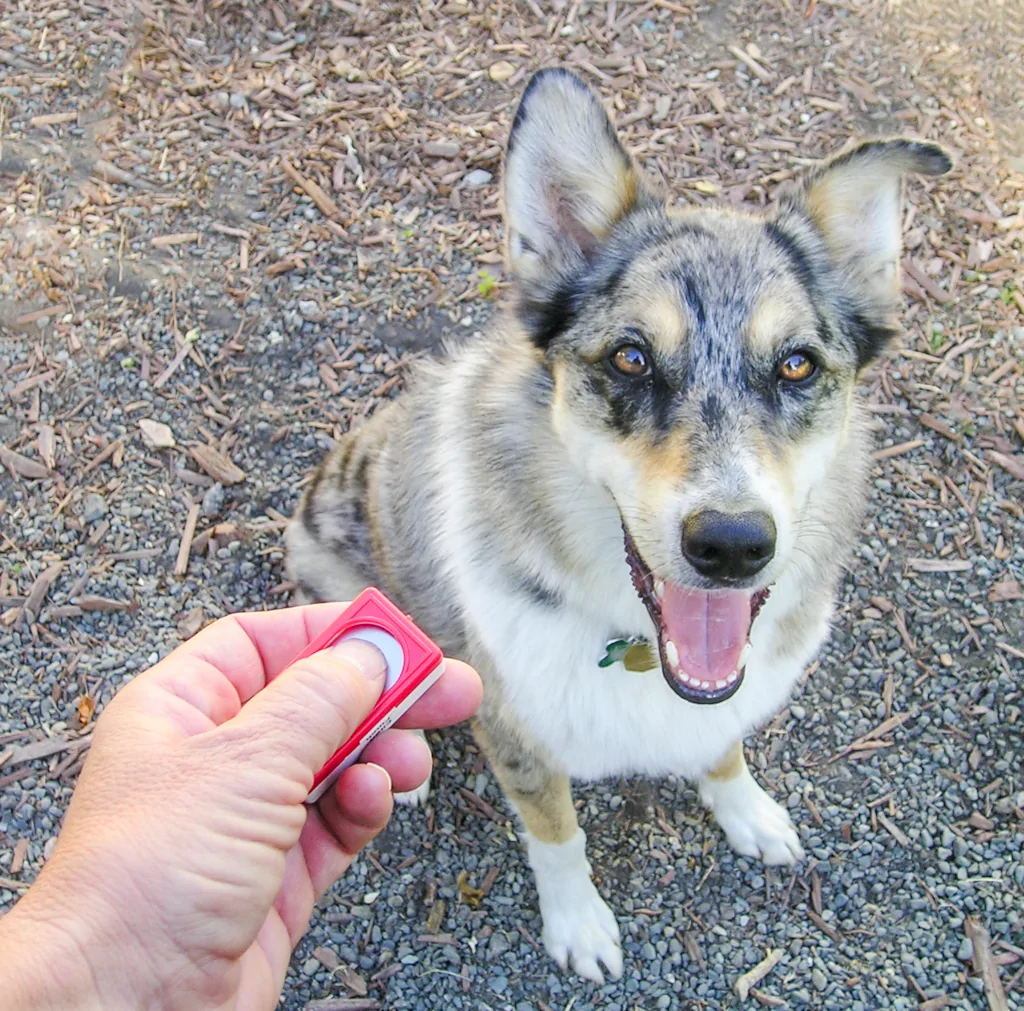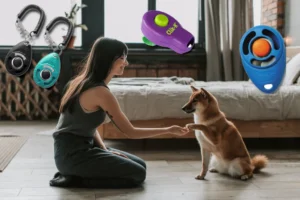Note: We may earn a commission from helpful, relevant links in our content. No cost to you. See our privacy policy.
Imagine the frustration of trying to teach your dog a new trick or command, only to be met with confusion and a lack of progress.
Or perhaps you’re struggling to curb those pesky unwanted behaviors that seem to persist despite your best efforts.
Enter the world of clicker training, a powerful and effective method that can revolutionize your relationship with your four-legged companion.
When I first started using clicker training with my mischievous pup Charlie, I was amazed at how quickly he picked up new commands and ditched his habit of chewing on shoes. So, let’s discover the secret behind this game-changing training technique together!

What Is Clicker Training and How Does It Work?
Clicker training is a positive reinforcement method that relies on a small device, the clicker, which emits a distinctive clicking sound.
The key to clicker training is pairing the sound with a reward, usually a tasty treat. When your dog performs the desired action or behavior, you “mark” that moment with a click, followed by a reward.
This helps your dog to associate the click with a positive experience, and over time, they learn that their actions can earn them rewards. With consistency and practice, your dog will start to respond to the clicker alone, making it an invaluable tool in shaping their behavior.
The Benefits of Clicker Training for You and Your Dog
Clicker training offers numerous benefits for both you and your furry friend. Here are a few highlights:
- Effective communication. The clicker provides a clear and consistent signal that helps your dog understand exactly what you want from them, reducing confusion and strengthening the bond between you.
- Positive reinforcement. By rewarding your dog’s good behavior, clicker training promotes a positive learning environment and encourages them to keep trying. This approach is far more effective and enjoyable than punishment-based techniques.
- Quick results. Clicker training enables faster learning, as dogs can quickly grasp the connection between the click and the reward. You’ll be amazed at how rapidly your pup masters new skills!
- Versatility. Clicker training can be used to teach your dog a wide range of behaviors, from basic commands like “sit” to more advanced tricks and even to address unwanted habits.
- Increased confidence: As your dog experiences success with clicker training, they will gain confidence in their abilities, making them more eager to learn and engage with you.
Getting Started: Choosing the Right Clicker and Treats
To ensure your clicker training journey is off to a great start, it’s essential to have the right equipment and treats on hand. In this section, we’ll guide you through selecting the perfect clicker and treats for your dog.
Selecting a Clicker
There are various types of clickers available on the market, but the key is to find one that is comfortable to hold and easy to use. Here are some factors to consider when choosing a clicker:
- Sound. Different clickers produce different clicking sounds. Pick one that is clear and distinct, but not too loud or startling for your dog.
- Size. Choose a clicker that comfortably fits in your hand and allows for easy clicking. Remember, you’ll be using it frequently during training sessions.
- Attachment options. Some clickers come with a wrist strap or keyring attachment, making them easier to keep track of during training.
- Durability. Opt for a clicker that is made of high-quality materials and built to last, as it will be an essential tool throughout your dog’s training.
Here are a few popular clicker options to consider for your dog training needs:
Karen Pryor i-Click Clicker is another great option. Known for its softer, more gentle click sound, it’s perfect for sensitive dogs.
Choosing the Right Treats
Treats play a crucial role in clicker training, so it’s vital to select ones that your dog loves and will be motivated to work for. Here’s what to look for when choosing treats:
- High value. High-value treats are those that your dog finds particularly enticing. These may be small pieces of cooked chicken, cheese, or commercial dog treats. Experiment with different options to find what your dog loves the most.
- Size. Treats should be small and easy for your dog to consume quickly. Large treats can slow down the training process, while small treats keep your dog focused and eager to learn.
- Nutrition. Opt for healthy treats that are low in calories and made from natural ingredients. This will ensure your dog maintains a balanced diet while keeping them motivated during training sessions.
- Variety. Mix up the treats you use during training to keep your dog interested and excited. Rotating between a few different options can help prevent boredom and maintain their motivation.
Go here for step-by-step guide on choosing the right training treat for your dog. We covered everything from nutrition, to diet and taste.
If your dog is picky, we have a guide for picky eaters with many high-value treat options to choose from. With the right clicker and treats at your disposal, you’re well on your way to embarking on a successful clicker training journey with your furry friend.
Once you’re done with that you can move on to some of the basic commands and exercises with by using a clicker. Follow this guide to get started.

Training Tips: Timing, Consistency, and Patience
To make the most of your clicker training experience, it’s essential to focus on three key aspects: timing, consistency, and patience. Let’s take a closer look at each of these components and how they contribute to successful training.
Timing
The effectiveness of clicker training depends on precise timing. When your dog performs the desired behavior, you must click and reward them as quickly as possible.
This helps your dog associate the correct behavior with the click and the treat. To improve your timing, practice clicking the moment your dog engages in the desired action, and immediately follow up with a reward.
Consistency
Being consistent in your training is crucial to help your dog understand what’s expected of them. Stick to the same cues, commands, and hand signals for each behavior, and always use the clicker in the same manner.
Consistency also applies to your training schedule, which means ensuring you dedicate regular time to clicker training sessions to reinforce your dog’s learning.
Patience
Patience is perhaps the most important aspect of clicker training. Remember that your dog is learning, and it takes time for them to understand new commands and behaviors.
Be prepared for setbacks, and don’t become frustrated if your dog doesn’t immediately grasp a new skill. Stay calm and patient, and continue to offer positive reinforcement as your dog learns at their own pace.
By focusing on timing, consistency, and patience, you will create a strong foundation for your clicker training sessions. This approach will not only yield faster results, but also foster a positive and enjoyable learning environment for both you and your dog.
Troubleshooting Common Clicker Training Issues
Even with the best intentions, you may encounter some challenges as you begin your clicker training journey. Let’s address some common issues and provide practical solutions to help you overcome them.
Issue 1: Dog doesn’t respond to the clicker
If your dog doesn’t seem to respond to the clicker or loses interest in the training, it’s possible they haven’t made the connection between the click and the reward.
To resolve this issue, start by “charging” the clicker. This involves clicking the clicker and immediately giving your dog a treat, even if they haven’t performed any specific behavior. Repeat this process several times until your dog begins to anticipate the treat after hearing the click.
Issue 2: Dog performs unwanted behaviors during training
Sometimes, your dog may engage in unwanted behaviors during training sessions, such as jumping, barking, or becoming overly excited. When my dog Sam first started clicker training, he would jump up and try to snatch the treat from my hand.
To address this issue, I made sure to only click and reward calm, desired behaviors. Ignore the unwanted behaviors, and remain patient as your dog learns to focus on the task at hand.
Issue 3: Dog only responds to the clicker
In some cases, your dog may become too reliant on the clicker and only perform the desired behaviors when they hear the click.
To prevent this, gradually phase out the clicker by clicking and treating less frequently, and eventually replacing it with verbal praise or a hand signal. This will help your dog become more responsive to cues other than the clicker.
Issue 4: Progress is slow or inconsistent
If you find that your dog’s progress is slow or inconsistent, it’s important to evaluate your training approach.
Ensure that you’re maintaining consistency in your cues, commands, and training schedule. Additionally, consider adjusting the difficulty of the behavior you’re trying to teach. Break it down into smaller steps, and click and treat each successful step before moving on to the next. This will make the learning process more manageable for your dog.
By addressing these common clicker training issues and applying the provided solutions, you’ll be well on your way to overcoming any obstacles and enjoying a successful training experience with your beloved pup.
Once you know how to trick train your dog, you can teach them anything from basic obedience commands, to tricks like “leave it“, to tricks like “roll over“, “play dead“, “spin/twirl“, “shake/paw“, “high five“, “bow“, “fetch“, and many others.
Here’s a simple video on how to get started with clicker training your puppy:
FAQs
Can I clicker train more than one dog at a time?
It’s best to conduct individual clicker training sessions for each dog to maintain focus and ensure consistent progress, but you can train multiple dogs in a single day with separate sessions.
Is clicker training suitable for all dog breeds?
Clicker training is a versatile method that can be effective for all dog breeds, as it relies on positive reinforcement and can be tailored to each dog’s unique personality and learning style.
How long should each clicker training session last?
Aim for short, focused sessions lasting about 5-15 minutes to keep your dog engaged and prevent fatigue. Conduct multiple sessions throughout the day if needed.
Can clicker training be used to correct unwanted behaviors?
Yes, clicker training can be used to correct unwanted behaviors by teaching and reinforcing alternative, desired behaviors, and ignoring or redirecting the undesired actions, such as chewing, excessive barking, or pulling on the leash.
Alex, a passionate animal lover, has experience in training and understanding animal behavior. As a proud pet parent to two dogs and three cats, he founded AnimalReport.net to share insights from animal experts and expand his knowledge of the animal kingdom.









